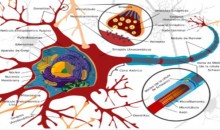Portada del sitio > Estudios Científicos > Could Myelin Damage From Radiofrequency Electromagnetic Field Exposure Help (...)
Journal of Toxicology and Environmental Health

Could Myelin Damage From Radiofrequency Electromagnetic Field Exposure Help Explain the Functional Impairment Electrohypersensitivity?
Viernes 12 de septiembre de 2014 · 2305 lecturas
Journal of Toxicology and Environmental Health, Part B: Critical Reviews
Volume 17, Issue 5, 2014
Could Myelin Damage From Radiofrequency Electromagnetic Field Exposure Help Explain the Functional Impairment Electrohypersensitivity? A Review of the Evidence
DOI:
10.1080/10937404.2014.923356
Mary Redmayneab* & Olle Johansson
pages 247-258
Publishing models and article dates explained
• Published online: 09 Sep 2014
Abstract
Myelin provides the electrical insulation for the central and peripheral nervous system and develops rapidly in the first years of life, but continues into mid-life or later. Myelin integrity is vital to healthy nervous system development and functioning. This review outlines the development of myelin through life, and then considers the evidence for an association between myelin integrity and exposure to low-intensity radiofrequency electromagnetic fields (RF-EMFs) typical in the modern world. In RF-EMF peer-reviewed literature examining relevant impacts such as myelin sheath, multiple sclerosis, and other myelin-related diseases, cellular examination was included. There are surprisingly little data available in each area, but considered together a picture begins to emerge in RF-EMF-exposed cases: (1) significant morphological lesions in the myelin sheath of rats; (2) a greater risk of multiple sclerosis in a study subgroup; (3) effects in proteins related to myelin production; and (4) physical symptoms in individuals with functional impairment electrohypersensitivity, many of which are the same as if myelin were affected by RF-EMF exposure, giving rise to symptoms of demyelination. In the latter, there are exceptions; headache is common only in electrohypersensitivity, while ataxia is typical of demyelination but infrequently found in the former group. Overall, evidence from in vivo and in vitro and epidemiological studies suggests an association between RF-EMF exposure and either myelin deterioration or a direct impact on neuronal conduction, which may account for many electrohypersensitivity symptoms. The most vulnerable are likely to be those in utero through to at least mid-teen years, as well as ill and elderly individuals.
Ver el abstract original AQUÍ
PRESS RELEASE David Ironside 18/9/14
COULD MYELIN DAMAGE FROM RADIOFREQUENCY ELECTROMAGNETIC FIELD EXPOSURE HELP EXPLAIN THE FUNCTIONAL IMPAIRMENT ELECTROHYPERSENSITIVITY? A REVIEW OF THE EVIDENCE . One of the most compelling modern scientific debates concerns the potential health risks from our ever increasing exposure to the pulsed radiofrequency electromagnetic fields (RF-EMF) from cell phones, cordless phones, Wifi, cell towers etc. This invisible technology has been classified a Class 2B Carcinogen by the WHO’s International Agency for Research in Cancer (IARC) in 2011. The non-thermal radiation used by modern devices was found to be biologically active and a possible cancer-causing agent. There remain many questions such as the mechanism for how this radiation interacts with biological processes and what exposure level constitutes a health risk. For many people around the world who suffer from electrohypersensitivity, exposure levels and duration of exposure can be very limited before a variety of symptoms manifest. These include headaches, lethargy, dizziness, lack of concentration, pain, insomnia, depression and more. - In Sweden electrohypersensitivity is an officially fully recognized functional impairment with an estimated 2.6 -3.2% of the population suffering from it. -In Austria an estimated 3.5% of the population. -In California the prevalence of self-reported sensitivity was 3.2%. With similar figures in other countries, there is a significant number of the population that has adverse physical reactions to even small amounts of exposure to low intensity radiofrequency electromagnetic fields (RF-EMF). The question of how some people could have such an adverse reaction to these fields is the subject of this paper. Olle Johansson PhD and Mary Redmayne PhD hypothesise that these fields may have a serious impact on the myelin which surrounds nerves. The human nervous system works by generating electrical signals and chemicals. But, as with household wiring, the human electrical system needs insulating. This fatty insulation is called myelin. Its importance lies in the fact that it allows the nervous system to send messages within the brain and around the body quickly. It develops as a spiral wrap around nerves, growing thicker and more effective with age. If there is a deterioration or demyelination around the nerves a variety of symptoms are experienced. Many of which are very similar to those suffered by persons with the functional impairment electrohypersensitivity. This review examines whether there may be a connection between symptoms reported after exposure to RF-EMF (chronic and acute non-thermal exposure) and compromised myelin integrity. Is there any evidence to suggest it, and is the hypothesis reasonable? These are
Ver el artículo original en pdf







